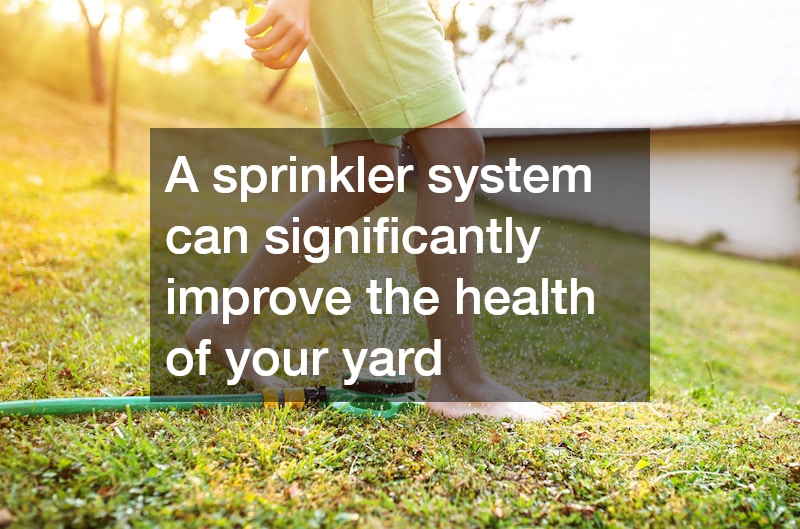Taking Your Dry Lawn from Drab to Fab with Lawn Sprinkler Systems
Transforming a dry, lackluster lawn into a vibrant green space is a common goal for many homeowners. A lawn sprinkler system can dramatically enhance the health and appearance of your lawn. This article will explore the key aspects of sprinkler systems and guide you through selecting, installing, and maintaining them effectively.
How to Choose the Right Sprinkler System?
Assessing Your Lawn’s Needs
Before delving into specific types of sprinkler systems, it’s essential to assess your lawn’s unique requirements. The size of your lawn will dictate the range and coverage needed from your sprinkler system. Soil type plays a pivotal role in water retention, affecting how long and how often you will need to run your sprinkler system.
Additionally, sun exposure and shade variations across your yard can influence water needs. By thoroughly understanding these factors, you can choose a system that ensures optimal growth and prevents water wastage. Proper evaluation leads to selecting a system that harmonizes with your lawn’s natural conditions.
Types of Sprinkler Systems
When selecting a sprinkler system, one of the first considerations is understanding the different types available. Drip irrigation systems are ideal for focused water delivery, particularly on flower beds and gardens.
Rotor sprinklers offer adjustable spray patterns, making them suitable for larger lawns where versatility and reach are important. Pop-up sprinklers, which retract back into the ground, are perfect for maintaining lawn aesthetics in smaller or medium-sized areas. Each type has its unique benefits, from precise water conservation to wide-angle coverage, allowing you to pick one that best meets your lawn’s infrastructure and watering needs.
What Are the Installation Steps for a Sprinkler System?
Preparation and Planning
The installation of a sprinkler system requires meticulous preparation. Begin by designing a layout that considers the dimensions of your yard and the reach required by each sprinkler head.
Checking water source availability is crucial to ensure that your system has sufficient pressure and flow rate. Acquire the necessary tools and materials, such as PVC pipes, connectors, and sprinkler heads, to facilitate a smooth installation process. With a clear plan in place, you can avoid common pitfalls during installation and ensure that your system operates optimally.
Step-by-Step Installation Process
The first step in installing your system is trenching, where you dig pathways for the pipes based on your layout. Once trenches are ready, lay the pipes and connect them to each other, ensuring secure joints that prevent leaks. Position and install the sprinkler heads at the prepared locations, making certain each head corresponds with your water range needs.
After assembly, test the system, checking for leaks and adjusting head alignments and water pressure. This detailed and structured approach guarantees a system that operates efficiently and caters to your lawn’s needs. A properly installed system boosts performance and minimizes maintenance in the long term.
How to Maintain Your Lawn Sprinkler for Optimal Performance?
Regular Maintenance Tasks
Routine maintenance is key to making sure your sprinkler system remains efficient. Regularly check for leaks, as these can lead to significant water waste if left unaddressed.
Cleaning sprinkler heads prevents clogs that can obstruct water flow and disrupt uniform coverage. Furthermore, ensure the system operates at the right water pressure to optimize water distribution and system longevity. Through consistent maintenance efforts, your system will run smoothly and extend its service life. Diligent upkeep preserves efficiency and supports a thriving lawn.
Seasonal Adjustments and Winterization
Adjusting your sprinkler system settings at the onset of each season can optimize watering schedules and conserve water. As temperatures fluctuate, so too do your lawn’s water needs, necessitating periodic recalibrations.
As winter approaches, it is vital to winterize your system to protect it from freeze damage. Drain residual water from pipes, hoses, and sprinkler heads to prevent expansion-induced cracks. Implementing these seasonal strategies helps in maintaining system integrity and preventing costly repairs. Regular adjustments and protective measures ensure continuous and effective operation throughout the year.
Investing in a sprinkler system for your lawn can significantly improve the health and aesthetics of your yard. By understanding how to select, install, and maintain your system, you can ensure your lawn remains lush and green throughout the year. Whether you’re navigating the vast array of choices or tackling maintenance tasks, the tips provided here will help convert your dry lawn into a fabulous outdoor space.
.





Post Comment